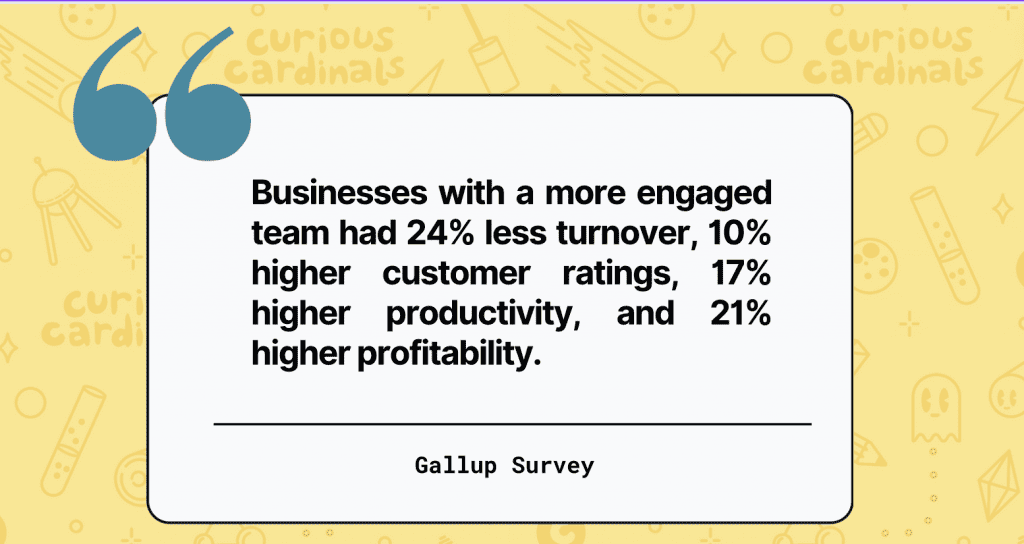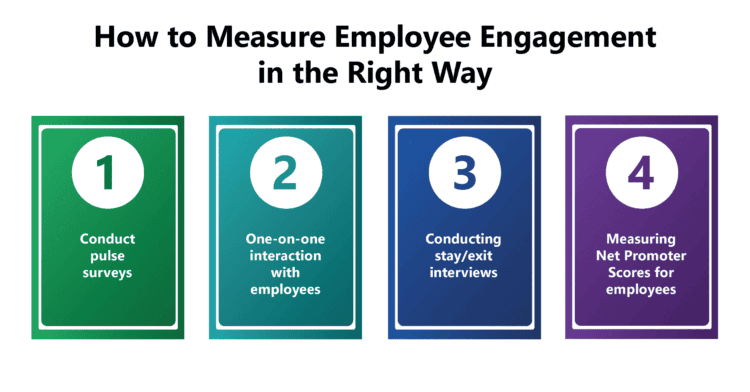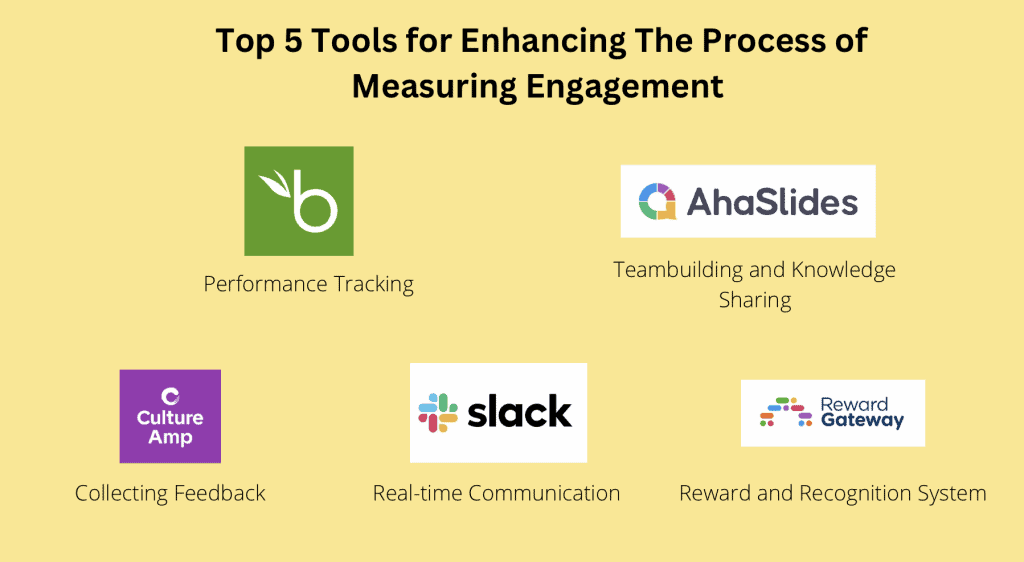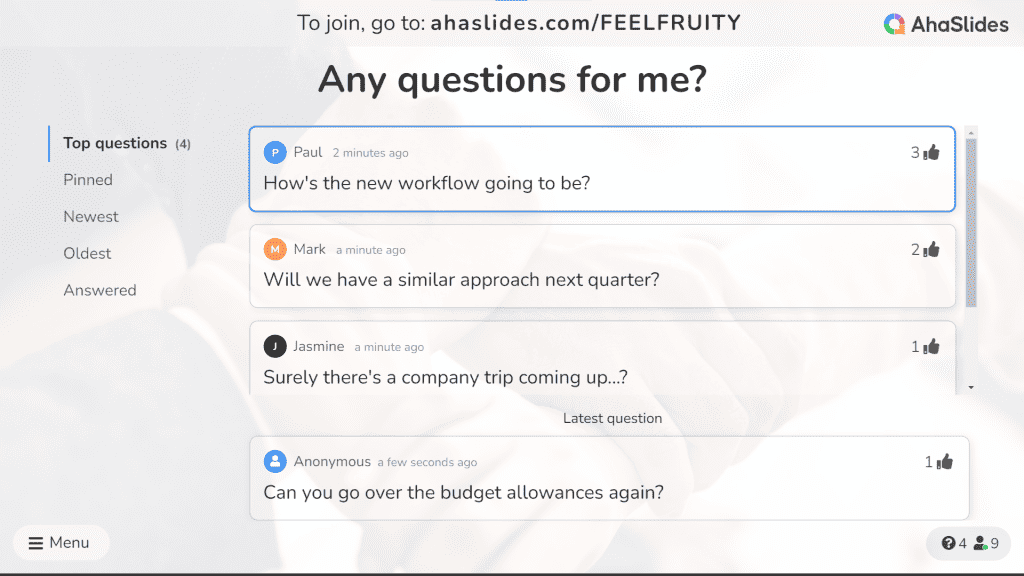참여 측정 프로세스 모든 회사에 있어서 대체할 수 없는 단계입니다.
오늘날의 경쟁적인 비즈니스 환경에서 성공하기 위해서는 직원 참여도를 측정하는 것이 중요합니다. 직원 참여도를 측정하면 조직의 전반적인 건강 상태에 대한 귀중한 통찰력을 제공하고, 개선 영역을 파악하며, 전략적 의사 결정에 필요한 정보를 얻을 수 있습니다.
참여 측정 프로세스가 필수적인 이유와 참여 측정 프로세스를 효과적으로 측정하고 개선하기 위한 주요 단계와 도구에 대해 알아보겠습니다.

목차 :
참여 측정 과정이 중요한 이유는 무엇입니까?

참여도 측정 프로세스는 기업이 더 나은 성과를 달성하고 긍정적인 변화를 더 빠르게 도약할 수 있는 첫걸음이며, 전략적 이니셔티브가 더 광범위한 조직 목표와 일치합니다. 기존 설문조사보다 우수한 성과를 달성하고, 직원 참여 실시간으로 더 많은 이점을 제공합니다.
- 문제를 예상하고 해결하세요: 실시간 측정을 통해 조직은 문제가 심각해지기 전에 사전에 예측하고 해결할 수 있습니다. 참여 지표를 지속적으로 모니터링함으로써 리더는 새롭게 발생하는 문제나 과제에 대한 즉각적인 통찰력을 얻을 수 있습니다. 이러한 선제적 접근 방식은 신속한 개입과 해결을 가능하게 하여 사기와 생산성에 부정적인 영향을 미칠 가능성을 방지합니다.
- 강점과 약점 식별: 참여도 측정 과정은 기업이 강점과 약점, 그리고 개선이 필요한 영역을 파악하는 데 큰 도움이 됩니다. 또한, 노력과 자원을 효과적으로 집중할 수 있도록 도와줍니다.
- 위협과 기회에 대비하세요: 데이터 기반 분석을 통해 조직은 위협과 기회와 관련된 현재 및 미래의 트렌드에 신속하게 대응할 수 있습니다. 참여도 감소를 신속하게 파악하면 직원 만족도와 유지율에 대한 잠재적 위협을 해결하는 데 도움이 될 수 있습니다. 반대로, 참여도의 긍정적인 변화를 파악하면 조직은 성장, 혁신, 그리고 생산성 향상의 기회를 활용할 수 있습니다.
- 직원 경험 향상: 직원들은 다음의 반응성을 높이 평가합니다. 지도 성장과 개선을 위한 그들의 우려와 피드백에 귀 기울입니다. 이 반복적인 피드백 루프는 긍정적인 직장 조직이 변화하는 요구 사항에 대응하고, 신뢰와 지속적인 참여의 문화를 구축하는 곳입니다.
참여 측정 과정을 효과적으로 수행하는 방법은 무엇인가?
참여 문화를 구축하는 것은 일회성 해결책이 아닙니다. 측정, 이해, 그리고 개선을 끊임없이 반복하는 과정입니다. 이 과정을 효과적으로 수행하는 데 도움이 되는 종합 가이드를 소개합니다.
직원 참여 지표 이해
참여도 측정 과정은 직원 참여도 지표를 이해하는 것에서 시작됩니다. 이는 직원에 대해 이해하는 데 도움이 되는 중요한 지표이며, 직원 참여도에 대한 귀중한 통찰력을 얻기 위해 동시에 조사할 수 있습니다.
- 자발적 직원 이직률: 일정 기간 내에 자발적으로 회사를 떠나는 직원의 비율(이상적으로는 10% 미만)을 측정하는 데 사용됩니다. 높은 이직률은 불만족이나 기타 근본적인 문제를 나타낼 수 있습니다.
- 직원 유지율: 이는 일정 기간 동안 회사에 근무하는 직원의 비율을 나타냅니다. 높은 유지율은 직원들이 자신의 역할에서 가치와 만족을 찾고 건강한 업무 환경을 갖추고 있음을 나타냅니다.
- 장기 결석: 이는 불만이나 소진을 나타낼 수 있는 계획되지 않은 직원 결근율을 추적하는 것을 목표로 합니다.
- 직원 순추천지수(eNPS): 직원들이 회사를 일하기 좋은 직장으로 추천할 가능성을 측정한 것입니다(70점 이상이면 좋은 것으로 간주됨).
- 직원 만족도: 설문조사를 통해 고용주는 만족도에 영향을 미치는 요소를 파악하고 참여 전략을 맞춤화하는 데 도움이 될 수 있습니다.
- 직원 성과: 참여 수준과 관련이 있으며, 개인이 조직에 어떻게 기여하는지에 대한 포괄적인 시각을 제공합니다. 네 가지 핵심 지표에는 업무 품질, 업무량, 업무 효율성, 그리고 조직 성과가 포함됩니다.
- 고객 행복: 직원 참여도와 고객 만족도의 상관관계를 파악하는 가장 좋은 방법입니다. 직원 만족도는 고객 만족도로 이어지는 경우가 많으므로, 이는 직원 참여도를 간접적으로 반영할 수 있습니다.

참여 측정 방법을 통한 후속 조치
참여도 평가를 위한 주요 지표를 파악한 후에는 설문조사 설계 및 배포, 결과 검토 및 분석 등 참여도 측정 프로세스가 진행됩니다. 직원 참여도 측정에 사용되는 몇 가지 주요 방법은 다음과 같습니다.
- 설문 조사 및 설문 조사: 직원들의 인식과 개선 영역을 파악하는 쉽고 비용 효율적인 방법입니다. 양적 설문조사와 질적 설문조사 모두 직장의 다양한 측면을 수집하는 데 효과적입니다.
- 감정 분석: 이는 내부 커뮤니케이션 채널(이메일, 채팅)을 활용하여 직원들의 감정과 잠재적 우려 사항을 파악합니다. 직원들의 미묘한 감정과 인식을 파악하는 가장 좋은 방법 중 하나입니다.
- 성능 검토: 평가 중 성능 검토 참여도 측정에 필수적입니다. 개인의 성과 목표가 더 광범위한 참여 목표와 얼마나 잘 부합하는지 연구합니다. 긍정적이고 참여적인 업무 환경에 꾸준히 기여하는 직원을 인정하고 강조합니다. 이는 직원 개발에 대한 건설적인 피드백을 제공하는 양방향 대화의 역할을 합니다.
- 체류 또는 퇴장 설문 조사: 직원들이 회사에 남거나 떠나기로 결정할 때 설문조사를 실시합니다. 이러한 결정의 이유를 이해하면 참여 활동의 효과와 잠재적인 개선 영역에 대한 실질적인 통찰력을 얻을 수 있습니다.
- 일대일 미팅: 정기 일정 일대일 채팅 직원과 관리자 간의 이러한 논의는 열린 소통의 장을 마련하여 관리자가 개별적인 우려 사항을 해결하고, 지원을 제공하며, 직원과 관리자 간의 관계를 강화할 수 있도록 합니다.
- 인정 및 보상 시스템: 직원의 뛰어난 기여나 업적을 파악하는 것부터 시작합니다. 지속적인 성장을 촉진하는 시스템을 구축합니다. 실시간 인식 긍정적인 행동의 추진력을 유지하려고 합니다.
참여 측정 프로세스 개선을 위한 5가지 주요 도구

참여도를 효과적으로 이해하고 측정하는 것은 복잡한 작업일 수 있습니다. 바로 이러한 이유로 이러한 도구들은 직원들의 참여도 수준을 세밀하게 파악하고자 하는 조직에 최적의 솔루션으로 부상했습니다.
1/ AhaSlides – 팀 빌딩 및 지식 공유
참여는 단순히 설문조사와 지표를 활용하는 것이 아니라, 연결과 공유 경험을 촉진하는 것입니다. 가장 좋은 방법 중 하나는 아하 슬라이드 실시간 퀴즈, 여론조사, Q&A 세션, 워드 클라우드 등 흥미로운 활동을 지원합니다. 팀 결속력 강화, 지식 공유, 실시간 피드백을 통해 재미있고 상호작용적인 방식으로 의견을 파악하고 개선할 부분을 파악할 수 있습니다.

2/ BambooHR – 성과 추적
뱀부HR 기존의 성과 평가를 넘어 지속적인 피드백 도구와 목표 설정 기능을 제공합니다. 이를 통해 직원 성과에 대한 지속적인 대화를 통해 개선 영역을 파악하고 성과를 축하할 수 있습니다. 개인의 발전과 발전을 추적함으로써 전반적인 참여도에 어떻게 기여하는지 파악할 수 있습니다.
3/ 문화 증폭 – 피드백
문화 앰프 설문조사, 펄스 체크, 퇴사 인터뷰를 통해 직원 피드백을 수집하고 평가하는 전문가입니다. 이 강력한 플랫폼은 피드백에 대한 정성적 및 정량적 분석을 제공하여 직원의 감정, 참여 요인, 그리고 잠재적 장애물에 대한 귀중한 통찰력을 제공합니다. 이 포괄적인 피드백 시스템은 직원들에게 중요한 것이 무엇인지 깊이 있게 이해하고 개선이 필요한 부분을 파악하는 데 도움을 줍니다.
4/ 보상 게이트웨이 – 인정
보상 게이트웨이 직원의 업적을 크고 작게 인정하고 보상하는 최고의 사이트 중 하나입니다. 개인 맞춤형 보상 프로그램을 만들고, 가상 또는 실물 선물을 보내고, 포상 활동의 효과를 추적할 수 있습니다. 이를 통해 감사하는 문화를 조성하고, 사기를 북돋우고, 참여를 유도할 수 있습니다.
5/ 슬랙 – 커뮤니케이션
느슨하게 실시간 커뮤니케이션을 용이하게 합니다. 협동 부서와 지역에 관계없이 직원들 간의 소통을 활성화합니다. 이를 통해 자유로운 대화, 지식 공유, 신속한 업데이트가 가능해져 사일로 현상을 해소하고 공동체 의식을 함양할 수 있습니다. 열린 소통을 장려함으로써 직원들이 자신의 의견이 존중받고 있다고 느낄 수 있는 공간을 조성할 수 있습니다.
하단 라인
💡직원 참여 수준을 평가할 때 개인 정보 보호 존중, 건설적인 피드백 제공, 그리고 다음을 보장하는 균형을 유지하는 것이 중요합니다. 긍정적인 작업 환경. 다음과 같은 직원 참여 도구 사용 아하 슬라이드 흥미롭고 참여도 높고 효과적인 설문조사와 기타 활동을 제공하는 데 완벽한 선택입니다.
자주 묻는 질문
참여를 측정하는 척도는 무엇입니까?
사용자 참여 척도(UES)는 사용자 참여도를 측정하기 위해 고안된 도구로, 다양한 디지털 영역에서 널리 사용되고 있습니다. 원래 UES는 31개 항목으로 구성되어 있으며, 심미적 매력, 집중력, 참신함, 지각된 사용성, 느낌 관여도, 그리고 지속성을 포함한 XNUMX가지 참여 차원을 측정하는 것을 목표로 했습니다.
직원 참여도를 측정하는 도구는 무엇입니까?
직원 참여 활동을 측정하는 데 사용되는 널리 사용되는 기술로는 직원 만족도 점수, 직원 순추천점수, 결근율, 직원 이직률 및 유지율, 내부 커뮤니케이션 수용성, 교육 후 설문 조사율 등이 있습니다.









